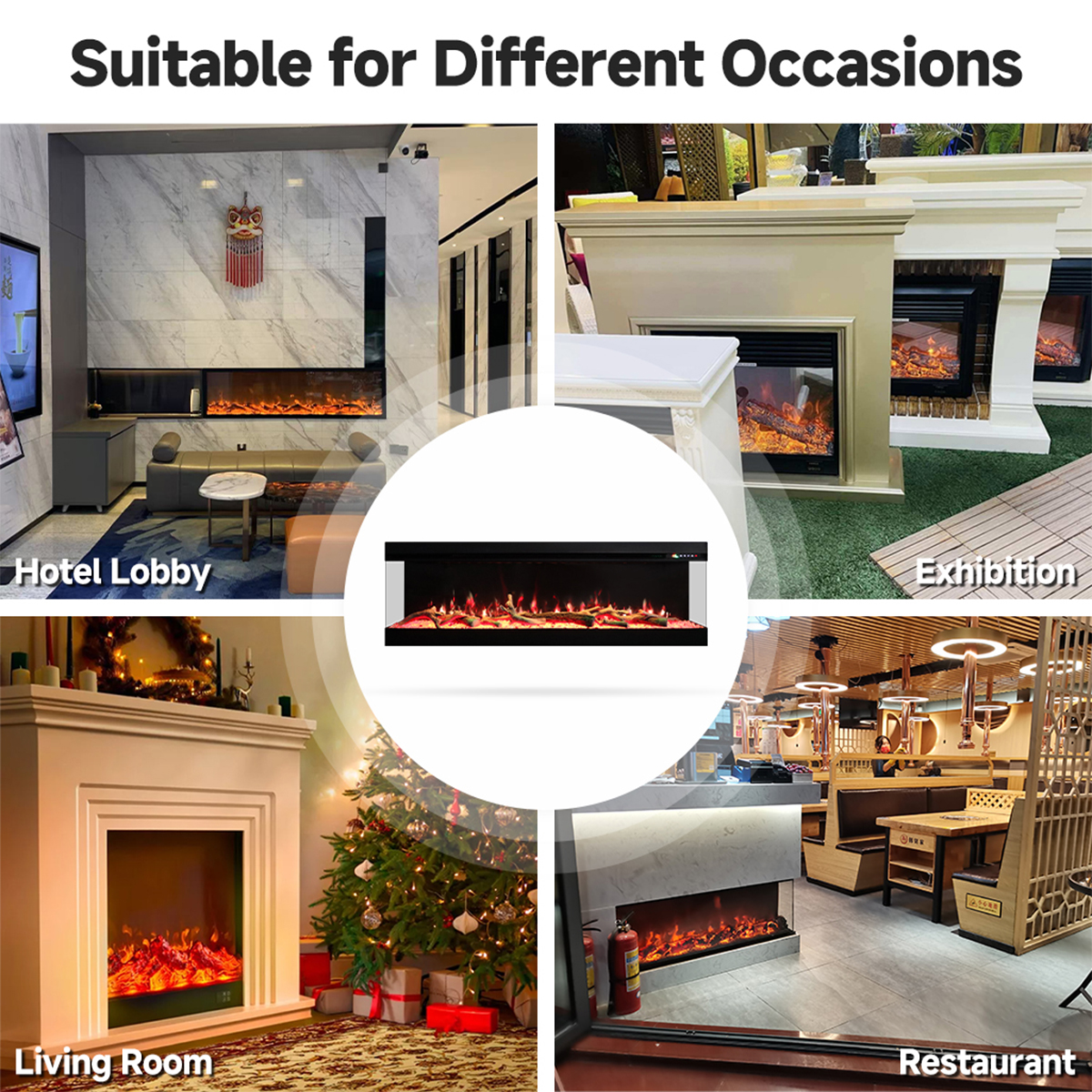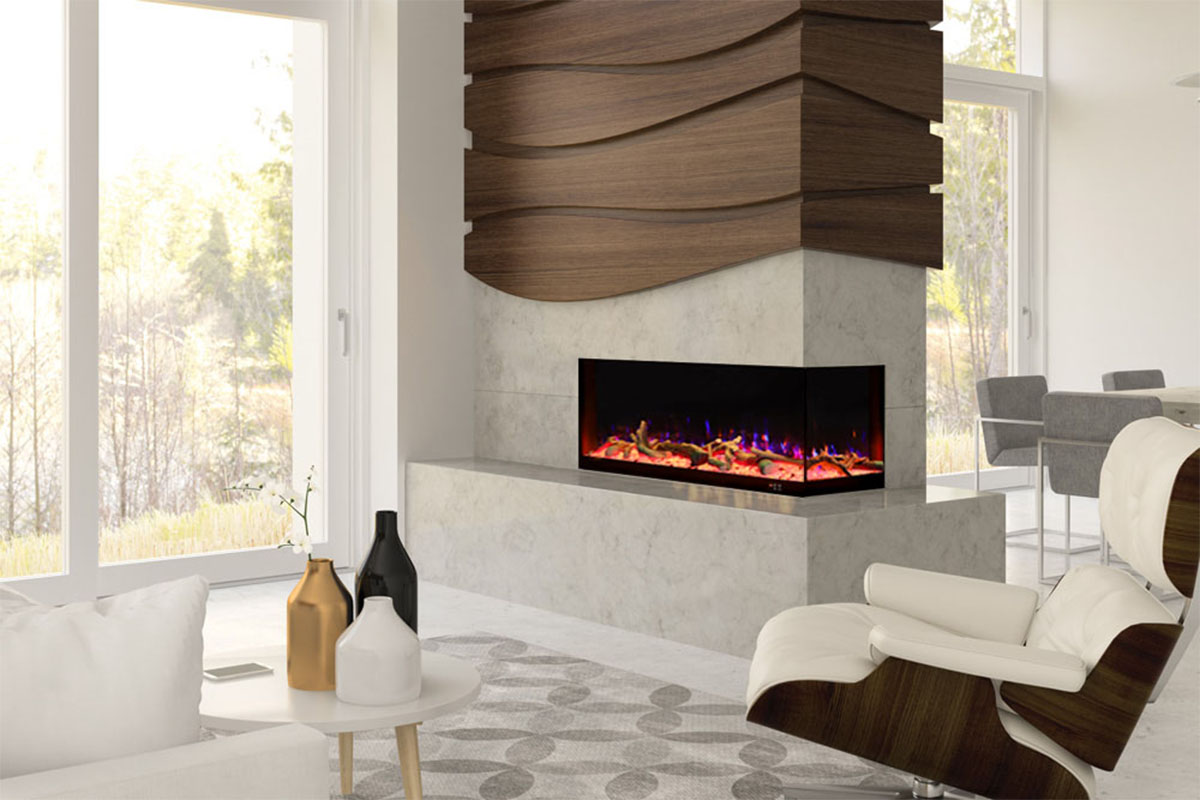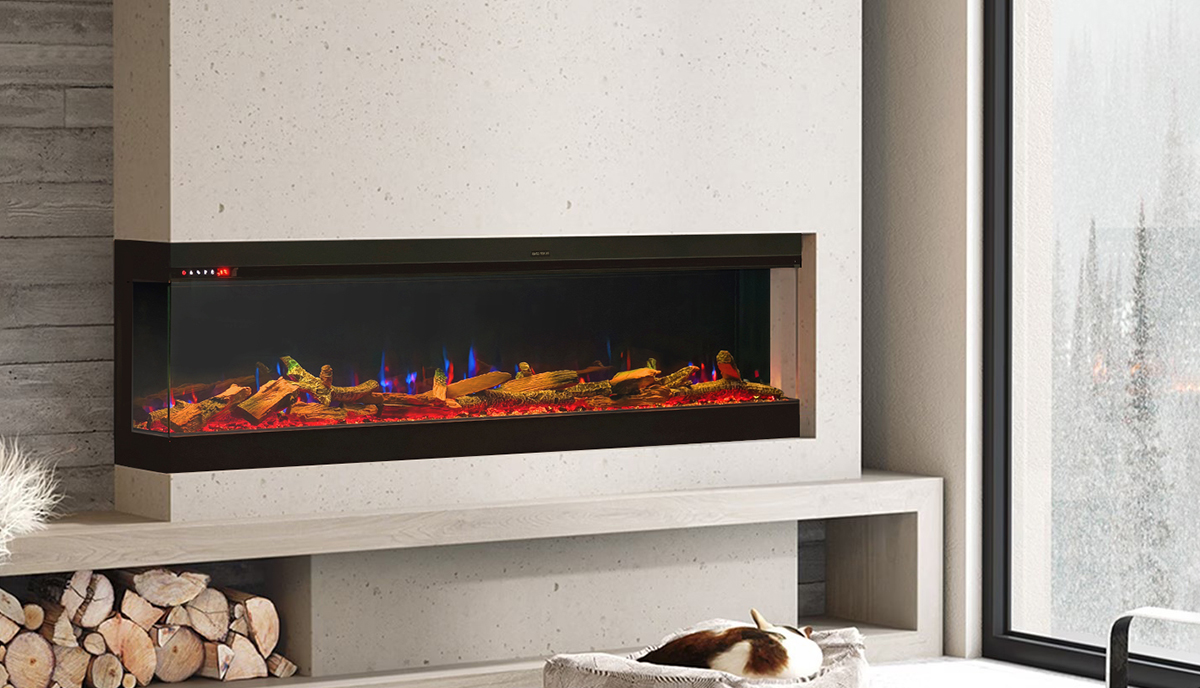Introduction: Breaking the Ambience Myth — Electric Fireplaces Are More Than Just a Mood
Can an electric fireplace actually generate heat?
The answer is yes — and it does so efficiently.
Electric fireplaces are not just for visual ambience anymore; they are powerful and intelligent supplemental heating systems.
In the past, people often viewed them merely as decorative elements, overlooking their heating capabilities. However, as the market and technology have evolved, modern electric fireplaces now deliver heat output comparable to traditional wood or gas fireplaces — combining design aesthetics with energy efficiency into one smart heating solution.
For hotel operators, real estate developers, and procurement managers in the furniture industry, purchasing an electric fireplace is no longer a purely decorative choice — it is a strategic investment decision that considers operational efficiency and long-term ROI.
With their low power consumption, minimal maintenance requirements, and strong aesthetic appeal, electric fireplaces add both functional and commercial value to spaces. Today, heat output has become a key metric for evaluating comfort, energy efficiency, and overall project performance.
This article provides practical data and analysis to support your business decisions, including:
-
The science and mechanisms behind electric fireplace heat generation
-
A comparison of key heating technologies (Fan-Forced vs. Infrared)
-
Heat output data (BTU, Watt) and their ROI implications
-
How electric fireplaces help reduce operational costs and enhance project value
Our goal: to help you make smarter, ROI-driven procurement and planning decisions.
II. The Science & Technology of Heat Output
A. Electric to Thermal: Efficient Zone Heating
Electric fireplaces operate entirely on electricity. Once plugged into a standard outlet (110V or 220V depending on your region), the current passes through a high-resistance heating element, converting electrical energy into heat.
This heat is then distributed via internal fans or infrared emitters, achieving nearly 100% efficiency — virtually all consumed power becomes usable warmth, making it both energy-saving and environmentally friendly.
Electric fireplaces are ideal as zonal heating solutions, not for heating entire buildings but for efficiently warming specific spaces without complex gas lines or ventilation systems.
Simply plug in the unit, and you’ll get immediate warmth — no energy wasted on unoccupied areas.
B. Two Core Heating Technologies
(1) Fan-Forced Heating — Even Warmth Through Air Circulation
This is the primary heating method used in Fireplace Craftsman’s products.
A built-in fan draws in cool air, passes it over a heating element, and circulates warm air evenly throughout the room.
Most models operate with two power settings: 750W and 1500W (≈2559 BTU and 5118 BTU), suitable for hotel rooms, show units, and small meeting spaces.
When heating starts, the fan initially circulates cool air while the element preheats; after reaching temperature, it delivers consistent warmth. Upon shutdown, the fan continues briefly to cool the element — protecting internal components and extending product life.
Fan-forced heating evenly distributes warmth across a medium-sized space (bedrooms, lounges, guest rooms, etc.).
If the fan is ever damaged during transport, it can be easily replaced or repaired locally — ensuring long-term serviceability.
(2) Infrared Heating — Direct, Gentle, and Highly Efficient Warmth
If fan-forced heating warms the air, infrared heating warms objects and people directly.
Infrared elements emit radiant energy similar to natural sunlight, offering quick, soft, and energy-efficient heat without drying the air.
This technology is ideal for larger or open areas, such as hotel lobbies, restaurants, or reception zones, where comfort and coverage matter most.
C. Dual Modes: Ambience or Heat — You Decide
Modern electric fireplaces feature two distinct operating modes: Decoration Mode and Heating Mode.
- Decoration Mode:
Only the LED flame effect is active, consuming about 20W of power — roughly 1 kWh per 50 hours of operation.
Perfect for ambience with minimal energy use.
- Heating Mode:
The internal heating element is activated, typically offering 750W / 1500W options to suit different room sizes and energy requirements.
During colder months, this provides effective supplemental heating; in warmer seasons, users can simply enjoy the visual flame effect without any heat output.
The independent control of both modes ensures year-round functionality — visual ambience in summer, efficient heating in winter — maximizing comfort and energy savings.
III. Quantifying Heat Output: Data for B2B Decision-Makers
A. Key Metrics: BTU and Watt
Electric fireplaces typically provide two heat settings — 750W and 1500W, equivalent to approximately 2559 BTU and 5118 BTU.
This heat output effectively covers up to 400 square feet (≈37 m²) of indoor space, making it ideal for:
- Hotel rooms and suites
- Short-term rental units and model homes
- Small conference or waiting rooms
B. Heat Output by Voltage Configuration
| Model Type | Power Configuration | Heat Output (BTU) | Recommended Applications |
|---|---|---|---|
| 120V Plug-in Model | Standard plug connection | 4000–5000 BTU | Multi-family homes, boutique hotel rooms, show units |
| 240V Hardwired Model | Direct electrical connection | 8000–9600 BTU | Hotel lobbies, upscale restaurants, commercial reception areas |
The 120V plug-in type is perfect for quick installations — no electrical rewiring required, just plug in and use (avoid multi-outlet extensions). It’s the best-value choice for smaller-scale projects.
The 240V hardwired type delivers higher heat output, providing strong, stable heating for larger commercial environments.
C. Beyond Specifications: From Heat Data to ROI Thinking
A growing trend among B2B buyers is to evaluate electric fireplaces not only for their aesthetics but also for their heating performance — as part of the project’s ROI calculation.
Today’s hotels and commercial spaces prioritize energy efficiency and comfort optimization over purely decorative solutions.
Electric fireplaces serve as localized heating and ambience enhancers, helping businesses achieve both comfort and cost control:
- Provide instant, localized warmth during colder months
- Offer flame-only operation for ambience during off-seasons
- Reduce the load on central HVAC systems, lowering total energy consumption
Long-term ROI benefits include:
- 10–20% reduction in total heating energy costs
- Extended lifespan of main HVAC systems
- Enhanced guest satisfaction and perceived luxury — crucial for hotels and premium developments
In short, the electric fireplace is not just a “decorative element” — it’s a functional investment tool that generates measurable returns in comfort, efficiency, and brand value.
IV. Commercial Applications & ROI Analysis
For B2B clients, investing in electric fireplaces goes far beyond aesthetic appeal — it’s a strategic investment that delivers measurable, long-term financial benefits.
Whether for hotels, real estate developments, or commercial interiors, electric fireplaces offer high installation flexibility, low maintenance costs, and excellent safety performance, making them an increasingly essential feature in global project designs.
A. Cost Savings: Installation and Maintenance
1. No Venting Required — Reduced Construction Costs
Electric fireplaces require no chimneys, gas lines, or venting systems.
They can be plugged in or hardwired directly, significantly reducing construction and integration costs.
For example, a mid-sized hotel replacing gas fireplaces with electric models could save 30–40% in installation expenses, while avoiding complex ventilation planning and approval processes.
This simplicity makes electric fireplaces ideal for hotels, apartments, and show units where installation time and space constraints are critical.
2. Low Maintenance and Operation Costs
Unlike wood or gas fireplaces, electric fireplaces produce no smoke, soot, or combustion residue.
They don’t require chimney cleaning or ash disposal — routine upkeep involves only wiping the glass panel to maintain clarity and aesthetics.
As a result, property management and after-sales maintenance costs are significantly reduced, enhancing long-term operational ROI for owners and operators.
B. Enhancing Guest Experience and Property Value
1. Hospitality Industry: Comfort and Ambience
Installing an individually controlled electric fireplace in each hotel room provides both supplemental heat and a cozy ambience, enhancing overall guest satisfaction.
Studies show that comfort is one of the top factors influencing positive reviews and repeat bookings.
For luxury and boutique hotels, an electric fireplace becomes both a temperature comfort feature and a visual marketing asset — a subtle detail that elevates the entire guest experience.
2. Developers and Builders: Market Appeal and Premium Value
Integrating modern, energy-efficient electric fireplaces into residential or commercial projects can significantly increase property appeal.
In model homes or showrooms, the visual and emotional warmth of an electric fireplace often boosts buyer engagement and perceived property value.
Data shows that properties featuring contemporary electric fireplaces tend to sell 15–20% faster than comparable listings without them — highlighting their tangible influence on sales velocity and marketability.
C. Safety: The Smart, Worry-Free Advantage
Safety remains a top priority in any commercial or residential setting.
Modern electric fireplaces are engineered for continuous, safe operation, featuring:
- Low-temperature glass fronts
- Overheat protection systems
- No open flame or combustion
These built-in safety measures make electric fireplaces smarter, more reliable, and more trusted by architects and investors — enhancing long-term brand reputation and project reliability.
D. A Long-Term Business Investment
| Value Dimension | Key Advantages | ROI Impact |
|---|---|---|
| Installation & Construction | No venting required, shorter installation time | 30–40% savings in initial cost |
| Maintenance & Operation | No ash, no combustion residue | Lower property management cost |
| Comfort & User Experience | Adjustable temperature and flame effects | Higher satisfaction & retention |
| Safety Performance | Cool-touch glass, overheat protection | Reduced liability & service risk |
An electric fireplace is not just a decorative product — it’s an intelligent asset that continues to generate value long after installation.
For hotel owners, developers, and distributors, it represents an ideal solution to maximize ROI, reduce maintenance expenses, and strengthen brand positioning in a competitive market.
V. Conclusion: Heat, Efficiency, and the Future
A. Electric Fireplaces: Redefining the Way We Heat
The question many buyers start with is: “Can an electric fireplace really produce heat?”
The answer is a definite yes.
Modern electric fireplaces deliver consistent, efficient heating while offering a cleaner, more flexible, and smarter way to warm a space.
Compared with gas or wood-burning models, they offer:
- Zero emissions — no smoke, no fumes, no venting required
- Energy conversion efficiency above 95%
- Multiple control methods — smart panel, remote, or app
- Year-round usability — decorative or heating mode as needed
This adaptability transforms electric fireplaces from seasonal decor into year-round comfort systems — key elements in creating micro-climate environments that balance aesthetics, comfort, and energy savings.

B. Emerging Trends: Smart, Sustainable, and Emotional Heating
1. Smart Energy Sync
Integration with smart grids and energy management systems allows fireplaces to automatically adjust output based on electricity pricing, occupancy, or time of day — optimizing both efficiency and cost.
2. Emotional Heating Design
Designers now treat fireplaces as emotional ambience devices rather than heating tools.
The flame visuals, crackling sound, and ambient lighting contribute to the psychological comfort of a space — creating a sense of human warmth and connection.
3. Sustainable Comfort Standards
As green building certifications such as LEED and BREEAM become mainstream, electric fireplaces are emerging as standard comfort amenities for sustainable hotels and commercial spaces — thanks to their recyclability, low emissions, and minimal energy consumption.
C. Call to Action: Let Data Drive Your Project Decisions
Every space has its own unique heating requirements.
If you’re planning a new hotel, residential, or commercial project, our team of specialists can help you with:
- BTU and power-matching calculations
- Customized efficiency recommendations
- Exclusive B2B OEM/ODM services
Let’s work together to bring smarter, more efficient, and more beautiful heating solutions to your projects — and transform heat into measurable comfort, value, and ROI.
Post time: Oct-30-2025



















